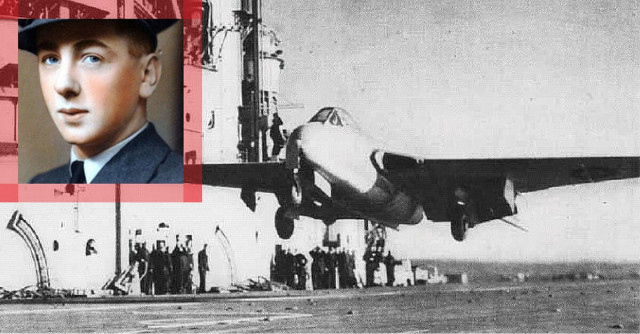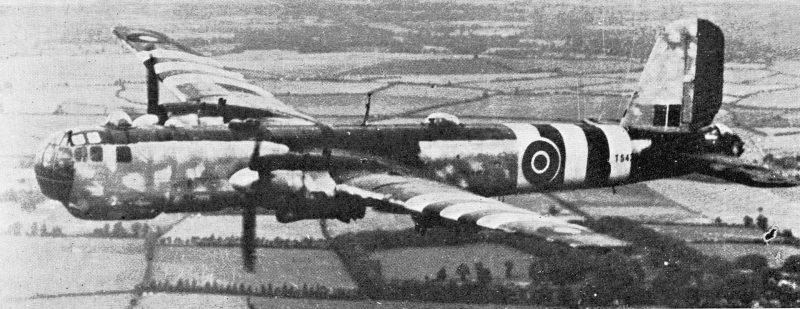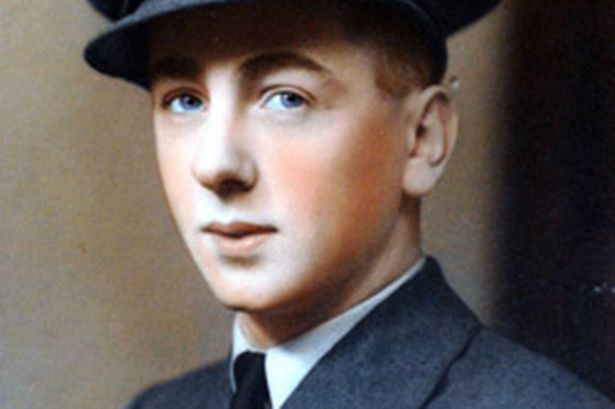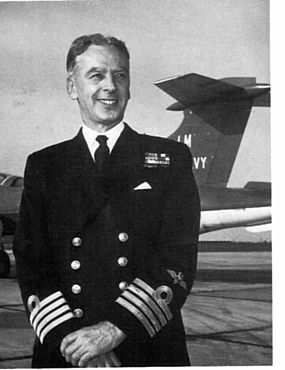 On
3 December 1945, Brown became the first pilot to land on and (pictured)
take-off from an aircraft carrier (HMS Ocean) in a jet aircraft. The
aircraft he flew – the de Havilland Sea Vampire LZ551/G – is now
preserved at the Fleet Air Arm Museum at Yeovilton, Somerset. Wikipedia
On
3 December 1945, Brown became the first pilot to land on and (pictured)
take-off from an aircraft carrier (HMS Ocean) in a jet aircraft. The
aircraft he flew – the de Havilland Sea Vampire LZ551/G – is now
preserved at the Fleet Air Arm Museum at Yeovilton, Somerset. WikipediaOn February 21st Captain Eric “Winkle” Brown died aged 97. During his long and distinguished career, he flew 487 different types of aircraft, made 2,407 deck landings at sea and 2,721 catapult launches. These world records he set are unlikely ever to be broken.
Captain Eric Brown has cemented his place in history since he has flown more planes than anyone else can count. What’s more is that his role in World War Two has more facets than just flying planes.
Eric also took part in the interrogation of leading Nazi party members and war proponents, including Goering.
He has been honoured with the AFC, DSC, MBE and OBE by King George VI all before he was 30 years old. Then later he received the King’s Commendation for Brave Conduct and a CBE from the current Queen Elizabeth II in 1970.
 The captured He 177 A-5 in British markings flown by Brown at Farnborough in September 1944
The captured He 177 A-5 in British markings flown by Brown at Farnborough in September 1944He was often consulted by researchers, historians and for documentaries, TV and films.
Flying was in Eric’s family since his father had served with the Royal Flying Corps during World War One. Eric and his father even attended the Olympics in Berlin in 1936 where they met the WWI German Luftwaffe’s ace pilots Ernst Udet and Hermann Göring, and Eric was even taken for a spin in one of their aircraft.
While studying German at Edinburgh University, Eric joined the university’s air squadron and remained in contact with some of the Luftwaffe’s star pilots who inspired him.
In February 1938 he returned to Germany, where, having been invited to attend the 1938 Automobile Exhibition by Udet, by then a Luftwaffe Major General, he saw the demonstration of the Focke-Wulf Fw 61 helicopter flown by Hanna Reitsch before a small crowd inside the Deutschlandhalle.
In the meantime, Brown had been selected to take part as an exchange student at the Schule Schloss Salem, located on the banks of Lake Constance, and it was while there in Germany that Brown was woken up with a loud knocking on his door one morning in September 1939. Upon opening the door he was met by a woman with the announcement that “our countries are at war”. Soon after, Brown was arrested by the SS. Fortunately, after 3 days incarceration, they merely escorted Brown in his MG Magnette sports car to the Swiss border, saying they were allowing him to keep the car because they “had no spares for it”.
Brown had learnt to fly in the University Air Squadron and when he made it back to Britain he volunteered for the Fleet Air Arm. He trained specifically as a naval pilot and begun to fly a Martlet fighter from the aircraft carrier HMS Audacity. The ship was torpedoed and sank in 1941 off the west coast of Spain.
Eric luckily survived, he believes because he had a life jacket that kept him afloat for hours before being rescued. Other crewmen weren’t so lucky, Brown was one of two aircrew who survived the sinking.

Eric’s talent for flying had been noticed, and he was transferred to Farnborough to be a test pilot. He had to work out the best ways to fly aircraft such as the new Spitfires and Hurricanes off and onto aircraft carriers to improve the capabilities of the Royal Navy.
In 1943 Brown resumed operational flying, being seconded to Royal Canadian Air Force (RCAF) squadrons flying escort operations to USAAF B-17s over France. His job was to train them in deck-landing techniques, though on airfields. As a form of quid pro quo he joined them on fighter operations.
By December 1943 Brown had already made some 1,500 deck landings on 22 ships and i. In 1944 he was appointed MBE for outstanding enterprise and skill in piloting aircraft during hazardous aircraft trials.
While at Farnborough as Chief Naval Test Pilot, Brown was involved in the deck landing trials of the Sea Mosquito, the heaviest aircraft to date to be flown from a British carrier. Brown landed one for the first time on HMS Indefatigable on 25 March 1944. This was the first landing on a carrier by a twin-engined aircraft.
Towards the end of the war, Eric was working at the top secret Aerodynamics Flight back in England. He was part of the team to provide a solution to defeating the German V1 bomb, which was hitting Britain at the time and had even destroyed Eric’s own home. They created a booster system that enabled British fighter planes to fly alongside the bombs and knock them off course.
Testing the solution was death-defying and on one test flight, Eric’s engine exploded and he had to eject out of the plane, luckily landing in a rural field.

Brown in front of a Blackburn Buccaneer, one of the record 487 different types of aircraft he has flown. Wikipedia
As the Allied advance towards Germany continued, Eric led a unit called the Enemy Aircraft Flight, which was tasked with the mission to find and seize as much German air force equipment as possible. On one of his many trips to the newly Allied-occupied areas of Germany, Eric was asked to act as an interpreter during a visit to a concentration camp near Belsen in northern Germany.
Eric had to interrogate the female chief of the camp and says he will never forget that she showed no regret or shame for what she had done. She was hanged after later.
Eric went on to interrogate many of the Nazi leaders especially those responsible for the Luftwaffe. Many continued their support for Hitler and felt they could justify their actions during the war.
Once the aftermath of World War Two had settled, Eric continued to test aircraft and aviation technology, working with the inventor of the jet engine, Sir Frank Whittle. By the end of his career, he had made just over 2400 aircraft carrier landings and flew almost 500 different types of aircraft, more than any other person in history.

Δεν υπάρχουν σχόλια:
Δημοσίευση σχολίου